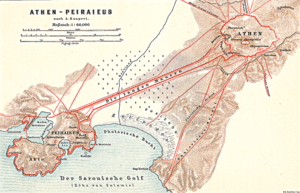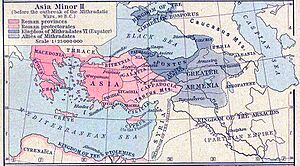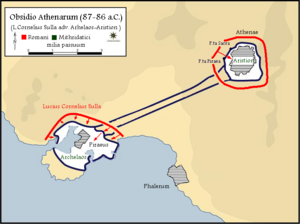Siege of Athens and Piraeus (87–86 BC) facts for kids
Quick facts for kids Siege of Athens and Piraeus |
|||||||
|---|---|---|---|---|---|---|---|
| Part of the First Mithridatic War | |||||||
 Map of the Athenian city wall encompassing both Athens and Piraeus. |
|||||||
|
|||||||
| Belligerents | |||||||
| Roman Republic | Kingdom of Pontus Athenian City-State |
||||||
| Commanders and leaders | |||||||
| Lucius Cornelius Sulla Lucius Licinius Lucullus Gaius Scribonius Curio Lucius Licinius Murena |
Commander-in-chief: Commanders Aristion (in command of Athens itself) |
||||||
| Strength | |||||||
|
total: 37,000–44,000 5 Roman legions (17,000–24,000 legionaires) 20,000 auxiliaries |
Unknown | ||||||
| Casualties and losses | |||||||
| Low | 400,000
|
||||||
The Siege of Athens and Piraeus was a major battle during the First Mithridatic War. It happened from autumn 87 BC to spring 86 BC. This fight was between the powerful Roman Republic, led by Lucius Cornelius Sulla Felix, and the forces of the Kingdom of Pontus along with the city-state of Athens. The Greek and Pontic armies were led by Aristion and Archelaus.
Contents
Why the War Started
The war began when Mithridates VI of Pontus, the king of Pontus, invaded the Kingdom of Bithynia. Bithynia was a friend and ally of Rome. Things got worse when many Roman citizens living in Asia Minor were harmed or killed in an event called the "Asiatic Vespers." This led to a big war between Rome and Pontus.
Soon, Mithridates VI took control of many Greek city-states that had been under Roman rule. In the spring of 87 BC, Roman forces led by Sulla landed in Greece. Sulla's main goal was to take back Athens. At that time, Athens was ruled by a leader named Aristion, who was loyal to Mithridates.
Sulla marched towards Athens, gathering supplies and more soldiers along the way. His main helper, Lucullus, went ahead to scout and talk with the Roman commander already in Greece. This commander, Bruttius Sura, gave his troops to Sulla. Ambassadors from most Greek cities met Sulla. He made it clear that Rome would remove Mithridates from Greece. Then, Sulla moved on to Athens.
The Siege Begins
When Sulla reached Athens, he faced a problem. The large outer wall that once connected Athens to its port, Piraeus, was broken. This meant Sulla had to attack two places at once. He built siege works around both Athens and Piraeus.
Archelaus defended Piraeus, while Aristion defended Athens itself. Defending Piraeus was easier because Pontus had a strong navy. This navy could bring in supplies and more soldiers whenever needed. Piraeus also had plenty of food and supplies from the start. Athens, however, did not.
Sulla decided to attack Piraeus first. He knew that without its port, Athens could not get new supplies. He sent Lucius Licinius Lucullus to gather a fleet from Rome's allies to fight the Pontic navy. Sulla's first attack on Piraeus failed. So, he decided to build huge earthworks. He needed a lot of wood for these. He cut down every tree, even sacred ones, from up to 100 miles away.
When Sulla needed more money, he took it from temples. The coins made from this money were used for many years because they were so good. After much effort, Sulla's siege works helped his army take the outer wall of Piraeus.
The Fight Continues
After taking the outer wall, Sulla found that Archelaus had built more walls inside Piraeus. Even though Sulla had surrounded both Athens and its port, the fight became a standstill. Archelaus tried several times to break the siege, but he couldn't.
Roman attention then turned to Athens, where people were starving. Inside the city, people were so hungry they were eating shoe leather and grass. A group from Athens went to talk with Sulla. But instead of serious talks, they just talked about how great their city was. Sulla sent them away, saying he was there to make rebels obey, not to listen to lessons.
Soon, Sulla's camp filled with people escaping trouble in Rome. These included his wife and children. Sulla realized that his political enemies had taken power in Rome. This meant he could no longer count on getting more money or soldiers. So, Sulla ordered his men to take resources from every temple and religious site nearby. One soldier was scared to take things from a temple because he heard strange voices. But Sulla told him to go back, saying the gods were happy with his victory.
As Athens starved, Aristion became less popular. Greek soldiers who left Aristion's side told Sulla that Aristion was not guarding a part of the city wall called the Heptachalcum. Sulla quickly sent engineers to dig under the wall. They brought down 900 feet of the wall between two gates on the southwest side of the city.
The Fall of Athens
On March 1, 86 BC, after five months under siege, the Romans attacked Athens at midnight. Aristion had made fun of Sulla, so Sulla was not in a forgiving mood. It was said that a lot of fighting happened in the streets. Only after his Greek friends and Roman senators begged him did Sulla decide to stop. After setting fire to large parts of the city, Aristion and his soldiers ran to the Acropolis. They had stored supplies there for a few weeks.
At the same time, Archelaus left Piraeus and gathered his forces in the city's fortress. Sulla wanted to stop Archelaus from escaping and joining other armies. So, he left the task of taking the Acropolis to Gaius Scribonius Curio Burbulieus. Sulla did not have a navy, so he could not stop Archelaus from escaping by sea. Archelaus was able to join another army sent by Mithridates VI. Sulla then marched into Boeotia to fight Archelaus's armies there. Before leaving the area, Sulla burned Piraeus to the ground.
Aristion and his group held out on the Acropolis for some time. But they eventually gave up when their water ran out. They also heard that Pontus had lost the Battle of Chaeronea. Aristion and his men were captured shortly after they surrendered.
What Happened Next
After defeating the Pontic army at the Battle of Chaeronea, Sulla won another battle at Battle of Orchomenus the next year. Sulla and Mithridates VI of Pontus finally met in 85 BC. They signed the Treaty of Dardanos, which ended the First Mithridatic War.
Sulla's army took Athens on February 12, 86 BC. The siege of Athens was a long and tough fight. Sulla's experienced Roman soldiers, who had fought in the Social War, caused a lot of damage to the city. Athens had chosen the wrong side in this war, which was seen by some as a fight for Greek freedom against Roman rule.
Athens was punished severely. This showed other Greek cities what would happen if they went against Rome. It helped keep Greece peaceful during later Roman civil wars and other Mithridatic wars.
See also



